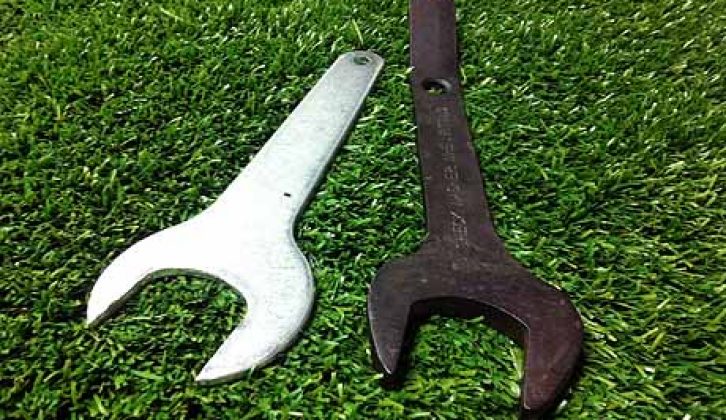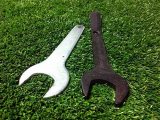By far, the most popular way of attaching a gas cylinder to a caravan is using a 30mm brass connector attached to a rubber hose.
On more modern caravans, the hose is short length of rubber with a nut on one end and an adaptor on the other. Older caravans have a length of rubber hose joined to a copper gas pipe using a worm drive (Jubilee) clip. A bottle-mounted regulator is attached to the other end of the rubber hose using a worm-drive clip.
Whichever system your caravan uses, a physical attachment between the caravan’s gas system and the gas cylinder is required. Usually this is achieved with a brass fitting, secured with a 30mm nut to ensure a safe, gas tight seal.
All this is very well, and most caravanners know this very well, but one part of the whole process which is generally overlooked is the means of tightening that 30mm nut.
The humble gas spanner is rarely purchased with any real thought. Many people have inherited them with their caravan. Or have used the same one for years and never worried.
But that is a mistake. Cheap gas spanners save a few pounds but cost you hassle or knuckles. Or both.
For the purposes of comparison, we have pictured at the top of the page, two gas spanners. Both are well used, but the one on the left cost £2. The one on the right cost £7.
The silver one cost £2 from a caravan accessory shop. It doesn’t matter which one. All caravan accessory shops sell them.
And they are rubbish.
Cheap spanners are cut from a sheet of 3mm steel and generally, they are acceptably close in size to the 30mm required to fit a caravan gas cylinder adaptor. Being cut from sheet means they often have sharp edges so care should be taken when using them.
The first problem comes once you have used them a few times. What happens is that the jaws of the spanner ‘spread’ in use. This means the gap between the two sides of the spanner gets wider. That means it doesn’t fit the gas fitting properly.
In normal use, this doesn’t really present a problem. If the gas fitting isn’t too tight, the ill-fitting, razor-edged spanner will undo (or do up) the fitting and you will get on with your holidays.
Inevitably however, one day, you will find that the gas fitting is done up a bit tight. Usually when the gas has run out. And it is raining.
At night.
Still, it’s no problem. You have a spare gas cylinder and your spanner to hand. You try and undo the fitting (remembering to go clockwise to do so). It won’t move. So you apply a little more pressure. Still, the brass nut will not rotate.
At this point, you decide to really give it some beans. You rest a foot on the a-frame, reposition the gas cylinder to get a better angle of attack and you really put some effort in to get the nut undone. You push hard and the spanner gives just a little, giving you that faint scrap of hope that it is about to give up the fight to cling onto the gas cylinder.
In fact what is happening is that the poorly fitting spanner is spreading, the edges of the brass nut defeating the cut edges of the economy gas spanner. The spanner is starting to slip. You might realise this if you thought about it. But you don’t. You want it to work.
This sign of encouragement leads you to pull just a little harder. With a slight grimace, you pull and after a second or two, your arm goes slack, the spanner turns and it takes a second for it to compute.
There is still and empty gas bottle attached to the caravan gas system, you are still in the dark, still getting wet. But now you have a deformed gas spanner and blood streaming from your knuckles.
All this could have been avoided if you had just spent an extra few pounds on a proper gas spanner.
A proper spanner is wider. The jaws are at least as wide as the nut. The spanner itself is not cut from a sheet of steel, but drop forged or maybe cast. It is reinforced around the jaw to ensure it is strong enough to cope with the rigour of the job it is required to do.
Run a rule over the jaw and you’ll see it is 30mm. Not 32 or 35mm. And if you do the same in ten years time and used it every day, it would still measure 30mm.
Placed securely on the nut for the gas cylinder and applying even pressure, it will not slip off. It can’t. It fits properly. The more effort you put in, the more energy that will go into turning that securing nut.
You will not be straining at the effort to deform a cheap spanner.
And chances are that after a couple of minutes, you will be heading back into the van, new cylinder connected and your knuckles intact, reaching for a bottle of Pinot Grigio and the TV remote, rather than the TCP and Elastoplast.
You may not be able to afford a new caravan, awning or tow car or your dreams. But I’d wager that spending an extra fiver on a gas spanner will improve your holiday more than a new £20k tourer. Again and again and again.
Cheap gas spanners save a few pounds but cost you hassle or knuckles. Or both.









